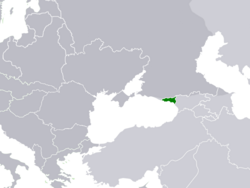Socialist Soviet Republic Abkhazia
| Socialist Soviet Republic of Abkhazia |
||||||||||
|
Советтә Социалисттә Республика Аҧсны (Abkhaz) Социалистическая Советская Республика Абхазия (Russian) |
||||||||||
|
||||||||||
|
|
||||||||||
|
Motto Пролетарии всех стран, соединяйтесь! Proletarii vsekh stran, soyedinyaytes'! "Proletarians of all countries, unite!" |
||||||||||
|
Anthem Интернационал Internatsional "The Internationale" |
||||||||||
|
The Socialist Soviet Republic of Abkhazia in 1921.
|
||||||||||
| Capital | Sukhumi | |||||||||
| Languages | Abkhaz, Georgian, Russian | |||||||||
| Government | Socialist Republic | |||||||||
| Legislature | Congress of Soviets | |||||||||
| History | ||||||||||
| • | Established | 31 March 1921 | ||||||||
| • | Disestablished | 19 February 1931 | ||||||||
| Area | ||||||||||
| • | 1926 | 8,600 km2 (3,300 sq mi) | ||||||||
| Population | ||||||||||
| • | 1926 est. | 201,016 | ||||||||
| Density | 23/km2 (61/sq mi) | |||||||||
| Currency | Ruble | |||||||||
|
||||||||||
The Socialist Soviet Republic of Abkhazia (SSR Abkhazia; Abkhaz: Советтә Социалисттә Республика Аҧсны, ССР Аҧсны; Russian: Социалистическая Советская Республика Абхазия, ССР Абхазия; Sotsialisticheskaya Sovetskaya Respublika Abkhaziya), was a short-lived republic within the Soviet Union that covered the territory of Abkhazia. It existed from 31 March 1921 to 19 February 1931. Formed in the aftermath of the Red Army invasion of Georgia in 1921, it was independent until 16 December 1921, when it agreed to a treaty uniting it with the Georgian Soviet Socialist Republic (Georgian SSR). It was unique among autonomous Soviet states in having de facto independence from Georgia. Through its status as a so-called "treaty republic" with Georgia, Abkhazia joined the Transcaucasian Soviet Federative Socialist Republic when it was formed in 1922. The SSR Abkhazia was abolished in 1931 and transformed into the Abkhaz Autonomous Soviet Socialist Republic within the Georgian SSR.
Throughout its existence, the SSR Abkhazia was led by Nestor Lakoba, who served officially as the Chairman of the Council of People's Commissars, but controlled the republic to such an extent it was jokingly referred to as "Lakobistan." Due to Lakoba's close relationship with Soviet leader Joseph Stalin, collectivization was delayed until after Abkhazia was incorporated into Georgia. Abkhazia remained a major tobacco producer, supplying over half of the country's supply. It also produced other agricultural products, namely tea, wine, and citrus fruits, leading to Abkhazia being one of the wealthiest regions in the Union. Its sub-tropical climate also made it a prime vacation destination, and Stalin and other major Soviet leaders all had dachas in the region and spent considerable time there. Though nominally led by the titular Abkhaz people, Abkhazia was ethnically diverse. The Abkhaz made up less than 30% of the population, while other major groups included Georgians, Armenians, Greeks, and Russians. Even though they did not form the majority, the Abkhaz were heavily favoured, and the Abkhaz language was promoted, a result of the korenizatsiia policies of the era. An Abkhaz national identity was promoted through these policies, instilling a sense of Abkhaz nationalism.
...
Wikipedia



